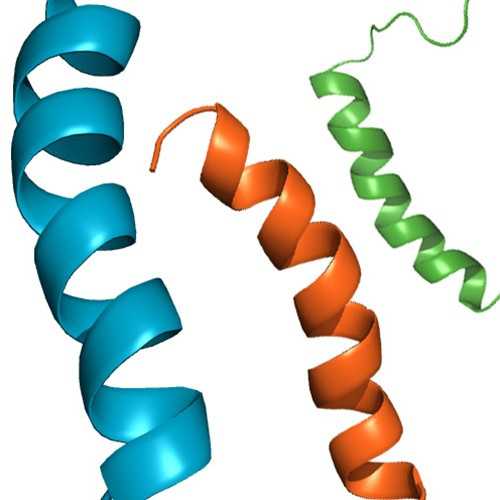G Protein Alpha i Inhibitor (Tat-GPR)
The Tat-GPR peptide was designed to functions as a guanine nucleotide dissociation inhibitor (GDI) that selectively inhibits the Gαi subunit.
Highlights:
- Based on a consensus sequence of the G protein regulatory (GPR) motif of AGS3 (also known as the GoLoco motif in RGS14)
- Highly Selective – Inhibits Gα while stimulating the activation of Gβγ signaling; Common pertussis toxin (PTX) inhibition stabilizes the entire heterotrimer
- Cell Permeable – Fused to portion the Tat (transactivator of transcription) HIV-1 protein
- Fast Acting – Tat-GPR works in minutes, whereas PTX inhibitors require over-night incubations
Mechanistically, GDIs are well suited to pursue receptor pharmacology of Gαi versus Gβγ signaling and their specific roles in cell signaling and disease. The Tat-GPR peptide stabilizes the GDP-bound conformation of Gαi, prevents the binding of AGS3 to Gαi subunits, blocks receptor coupling to G-protein, and Tat-GPR has shown efficacy in an in vivo model of cocaine addiction and in vitro models of cancer. Tat-GPR peptide at 100nM suppresses α2-AR associated cAMP/Gαi activity in cell culture.
From the laboratory of Yuri K. Peterson, PhD, Medical University of South Carolina.
The Tat-GPR peptide was designed to functions as a guanine nucleotide dissociation inhibitor (GDI) that selectively inhibits the Gαi subunit.
Highlights:
- Based on a consensus sequence of the G protein regulatory (GPR) motif of AGS3 (also known as the GoLoco motif in RGS14)
- Highly Selective – Inhibits Gα while stimulating the activation of Gβγ signaling; Common pertussis toxin (PTX) inhibition stabilizes the entire heterotrimer
- Cell Permeable – Fused to portion the Tat (transactivator of transcription) HIV-1 protein
- Fast Acting – Tat-GPR works in minutes, whereas PTX inhibitors require over-night incubations
Mechanistically, GDIs are well suited to pursue receptor pharmacology of Gαi versus Gβγ signaling and their specific roles in cell signaling and disease. The Tat-GPR peptide stabilizes the GDP-bound conformation of Gαi, prevents the binding of AGS3 to Gαi subunits, blocks receptor coupling to G-protein, and Tat-GPR has shown efficacy in an in vivo model of cocaine addiction and in vitro models of cancer. Tat-GPR peptide at 100nM suppresses α2-AR associated cAMP/Gαi activity in cell culture.
From the laboratory of Yuri K. Peterson, PhD, Medical University of South Carolina.
| Product Type: | Protein |
| Name: | Tat-GPR |
| Accession ID: | P19086, CAS: 419535-56-1 |
| Source: | Synthetic chemistry |
| Molecular Weight: | 4846.6 Da |
| Amino Acid Sequence: | TMGEEDFFDLLAKSQSKRMDDQRVDLAK |
| Fusion Tag(s): | GRKKRRQRRRPP |
| Format: | Powder |
| Purity: | >95% HPLC and MS data |
| Solubility: | Water or HEPES buffered water |
| Suggested Amount per Experiment: | 300nM (150ng in 100uL) |
| Comments: | Working stock=30mM |
| Storage: | Long term -20C |
| Shipped: | Ambient temperature |

- Appleton KM, Bigham KJ, Lindsey CC, Hazard S, Lirjoni J, Parnham S, Hennig M, Peterson YK. Bioorg Med Chem. 2014 Jul 1;22(13):3423-34. PMID: 24818958
- Bowers MS, McFarland K, Lake RW, Peterson YK, Lapish CC, Gregory ML, Lanier SM, Kalivas PW. Neuron. 2004 Apr 22;42(2):269-81. PMID: 15091342
- Oxford GS1, Webb CK. GoLoco motif peptides as probes of Galpha subunit specificity in coupling of G-protein-coupled receptors to ion channels. Methods Enzymol. 2004;390:437-50. PMID: 15488193.
- Peterson YK, Hazard S 3rd, Graber SG, Lanier SM. Identification of structural features in the G-protein regulatory motif required for regulation of heterotrimeric G-proteins. J Biol Chem. 2002 Mar 1;277(9):6767-70. Epub 2001 Dec 27. PMID: 11756403.
- Peterson YK, Bernard ML, Ma H, Hazard S 3rd, Graber SG, Lanier SM. Stabilization of the GDP-bound conformation of Gialpha by a peptide derived from the G-protein regulatory motif of AGS3. J Biol Chem. 2000 Oct 27;275(43):33193-6. PMID: 10969064.
- Kimple RJ, Kimple ME, Betts L, Sondek J, Siderovski DP. Structural determinants for GoLoco-induced inhibition of nucleotide release by Galpha subunits. Nature. 2002 Apr 25;416(6883):878-81.
- M'Kadmi C, Cabral A, Barrile F, Giribaldi J, Cantel S, Damian M, Mary S, Denoyelle S, Dutertre S, Péraldi-Roux S, Neasta J, Oiry C, Banères JL, Marie J, Perello M, Fehrentz JA. N-Terminal Liver-Expressed Antimicrobial Peptide 2 (LEAP2) Region Exhibits Inverse Agonist Activity toward the Ghrelin Receptor. J Med Chem. 2019 Jan 24;62(2):965-973. View Article
If you publish research with this product, please let us know so we can cite your paper.


